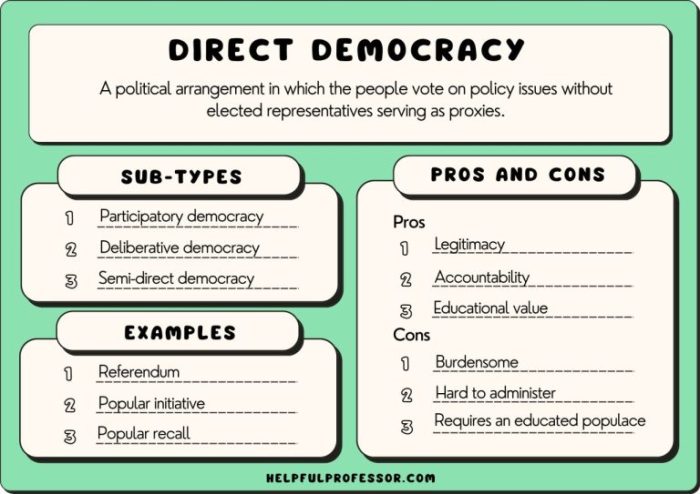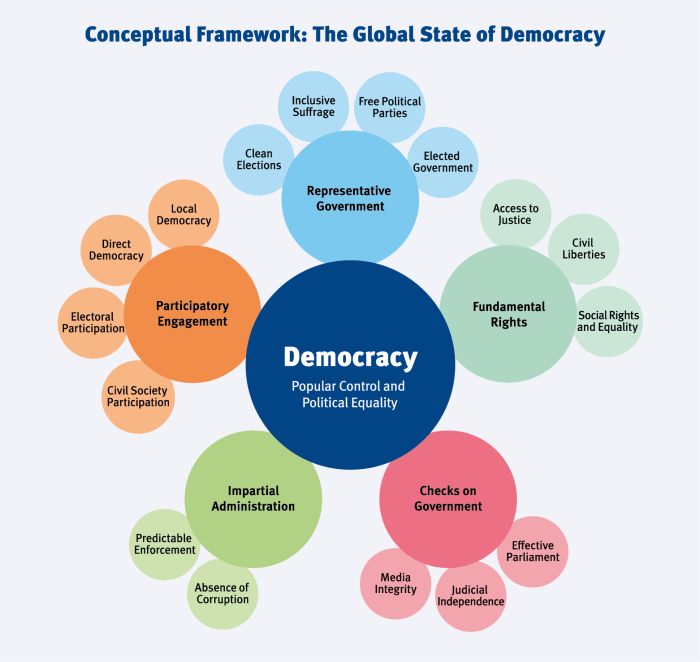Easy Drawing of Presidential Democracy

Elections in a Presidential Democracy: Easy Drawing Of Presidential Democracy

Easy drawing of presidential democracy – Understanding how a presidential democracy elects its leader is crucial to grasping the system’s essence. The process, while seemingly straightforward, can involve intricate systems designed to balance the will of the people with other considerations, often leading to fascinating variations across different nations. This section will explore some key aspects of presidential elections, offering simplified illustrations for easier comprehension.
The mechanics of electing a president differ significantly across countries. Some utilize a simple popular vote system, where the candidate with the most votes wins. Others employ more complex methods, such as electoral colleges, which add another layer to the process. Understanding these differences is key to understanding the nuances of presidential democracies.
The Electoral College System: A Simplified Illustration
Imagine a map of the United States, divided into colored regions representing individual states. Each state has a certain number of electors, roughly proportional to its population. These electors are not directly elected by the people but are pledged to vote for a particular candidate based on the popular vote within that state. In our drawing, we could depict each state as a box, with the number of electors written inside.
Larger states, like California or Texas, would have larger boxes with higher numbers. The candidate who wins the majority of electors (not necessarily the popular vote) wins the presidency. This system, while intended to balance the power of smaller states, can lead to situations where the popular vote winner loses the election, sparking considerable debate and discussion about its fairness and effectiveness.
A visual representation could show a color-coded map with state-by-state results, clearly indicating the total number of electors won by each candidate. A simple bar graph comparing the popular vote totals to the electoral college results would further illuminate this complex relationship.
Comparison of Electoral Systems in Presidential Democracies
A comparative chart could effectively illustrate different electoral systems. One column could list the country (e.g., United States, France, Brazil), another the type of system (e.g., Electoral College, Two-Round System, Direct Popular Vote), and a third could describe the key features of each system. For instance, the Two-Round System used in France requires a candidate to win an absolute majority; if no candidate achieves this in the first round, a second round is held with only the top two candidates.
Direct popular vote, as used in many Latin American countries, simply awards the presidency to the candidate with the most votes. Visual aids, like simple icons representing each system, could enhance understanding. The chart could also include a column showing potential advantages and disadvantages of each system, helping to highlight the trade-offs inherent in each approach.
The Presidential Election Process: A Simple Diagram, Easy drawing of presidential democracy
Our diagram would begin with a box labeled “Campaigning,” showing activities like rallies, debates, and advertising. An arrow would lead to a box labeled “Primary Elections/Caucuses,” illustrating the process of narrowing down candidates within each party. Another arrow would connect to a box labeled “General Election,” representing the national vote. From there, an arrow would lead to a box showing “Electoral College Vote” (if applicable), or “Counting Popular Vote” for systems without an electoral college.
Finally, an arrow would lead to the concluding box, “Inauguration,” signifying the formal beginning of the president’s term. The use of different colors and clear labeling would make the process immediately accessible. The diagram could also incorporate additional boxes for relevant steps, such as recounts or legal challenges, if needed, to provide a more comprehensive overview of the entire election cycle.
Powers and Responsibilities

Understanding the intricate dance of power in a presidential democracy requires a clear grasp of the distinct yet interconnected roles of its three main branches: the executive (President), the legislature, and the judiciary. This delicate balance, enshrined in the concept of separation of powers, is crucial for preventing tyranny and ensuring a fair and just society. A breakdown of their individual and overlapping authorities illuminates this vital system.
Separation of Powers: A Visual Metaphor
Imagine a three-legged stool. Each leg represents one branch of government: the President (executive), the Legislature (legislative), and the Judiciary (judicial). Each leg is strong on its own, representing the independent power of each branch. However, the stool only stands strong and functions properly when all three legs are equally strong and work together. If one leg is significantly weaker or broken (one branch has too little or too much power), the stool – the government – will collapse.
This illustrates how the balance of power between the three branches is essential for stability and effective governance. The overlapping areas where the legs connect represent the points where the branches interact and check each other’s power, preventing any one branch from becoming too dominant.
Powers and Responsibilities: A Detailed Breakdown
The following table visually represents the distribution of powers in a typical presidential democracy. Note that the specific powers and their extent can vary significantly depending on the country’s constitution and legal framework.
| President (Executive) | Legislature (Legislative) | Judiciary (Judicial) | Overlapping Powers |
|---|---|---|---|
| Enforces laws; appoints judges and officials; commands armed forces; veto power over legislation; proposes legislation; conducts foreign policy | Makes laws; approves budgets; declares war; ratifies treaties; oversees the executive branch through oversight hearings and investigations | Interprets laws; reviews legislation for constitutionality; settles disputes; protects individual rights | Appointment of judges (President nominates, Legislature confirms); Budget approval (President proposes, Legislature approves); Treaty ratification (President negotiates, Legislature ratifies); Impeachment (Legislature initiates, Judiciary tries) |
The Impeachment Process: A Visual Representation
Imagine a trial. The President, as the accused, stands before the Legislature, acting as the jury. The Legislature, based on evidence of wrongdoing (e.g., high crimes and misdemeanors), brings charges. This process is often complex and involves investigations, hearings, and a formal vote to impeach. If the Legislature votes to impeach (indicts), the President is then tried by the Judiciary.
The Judiciary acts as the judge and jury, deciding whether the evidence warrants removal from office. This multi-stage process, visualized as a sequential flow, highlights the checks and balances designed to prevent abuse of power and safeguard democratic principles. A successful impeachment requires a supermajority vote in the Legislature and a conviction in the Judiciary, emphasizing the seriousness of this ultimate check on presidential power.
Visualizing complex political systems like presidential democracies can be surprisingly simple. A basic diagram, perhaps using shapes to represent branches of government, can be very effective. Think of it like creating a simplified representation; it’s similar to the straightforward approach you’d take when finding an easy christmas tree drawing , focusing on the essential elements to convey the overall idea.
Returning to presidential democracies, even a rudimentary sketch can effectively illustrate the core power dynamics at play.
The entire process is meticulously documented and publicly scrutinized, underscoring the importance of transparency and accountability in a democratic system.
Strengths and Weaknesses

Presidential democracies, with their distinct separation of powers and directly elected executives, present a complex tapestry of advantages and disadvantages. Understanding these contrasting facets is crucial to appreciating the nuances of this system of governance and its suitability for different societies. A balanced perspective reveals both the potential for robust governance and the inherent risks of instability.
Analyzing the strengths and weaknesses requires a comparative approach, weighing the benefits against the drawbacks in a structured manner. This allows for a more informed assessment of the system’s overall effectiveness and its adaptability to various contexts.
Comparative Analysis of Strengths and Weaknesses
The following chart visually represents a comparison of the strengths and weaknesses of a presidential democracy. It is important to note that the relative importance of these factors can vary significantly depending on the specific political and social context of a given nation.
| Strength | Weakness |
|---|---|
| Strong executive leadership: A directly elected president provides clear accountability and decisive action. This is particularly valuable during times of crisis. | Potential for gridlock: Division between the executive and legislative branches can lead to political stalemate and impede effective governance. |
| Checks and balances: The separation of powers prevents the concentration of power in a single entity, safeguarding against tyranny. | Risk of executive overreach: A powerful president might attempt to circumvent checks and balances, potentially undermining democratic institutions. |
| Clear mandate: A president enjoys a direct mandate from the people, enhancing legitimacy and strengthening their position in negotiations with other branches. | Winner-takes-all system: This can lead to marginalization of minority viewpoints and a lack of inclusivity in policy-making. |
| Stability (potentially): A fixed term of office provides a degree of predictability and stability, allowing for long-term planning and policy implementation. | Instability (potentially): Impeachment processes or political crises can lead to periods of uncertainty and instability, undermining public trust. |
Gridlock in Presidential Systems
Gridlock, a significant weakness of presidential systems, arises from the inherent separation of powers. Imagine a scenario where the president’s party controls the executive branch, while the opposition controls the legislature. This division can lead to a complete standstill on crucial legislation, hindering progress and frustrating the electorate.
For example, consider a hypothetical situation where the president proposes a vital infrastructure bill. However, the opposition-controlled legislature refuses to pass it, perhaps due to partisan disagreements or strategic political maneuvering. This results in a prolonged period of inaction, potentially harming the nation’s economic development and social well-being. This scenario is visually represented as two opposing forces, the President and the Legislature, locked in a stalemate, with the infrastructure bill caught in the middle, unable to move forward.
Challenges to Stability
Several factors can threaten the stability of a presidential democracy. These challenges often intertwine and exacerbate each other, creating a complex web of potential risks.
Imagine a visual representation: a teeter-totter representing the balance of power. On one side are factors that promote stability (strong institutions, robust rule of law, economic prosperity). On the other are destabilizing forces (political polarization, economic inequality, weak institutions, corruption). When the destabilizing forces outweigh the stabilizing ones, the teeter-totter tips, representing a potential crisis or collapse of the democratic system.
Examples include the Venezuelan crisis, where economic mismanagement and political polarization led to significant instability, or the impeachment processes in the United States, which, while part of the system’s checks and balances, can still create periods of significant political uncertainty.
FAQ Explained
What are some common criticisms of presidential democracies?
Common criticisms include potential for gridlock between the executive and legislative branches, the risk of executive overreach, and the rigidity of the system, making it difficult to adapt to changing circumstances.
How does a presidential democracy differ from a parliamentary democracy?
In a parliamentary system, the executive branch (Prime Minister) is chosen from and accountable to the legislature. In a presidential system, the executive (President) is independently elected and holds a separate mandate from the legislature.
What role does the judiciary play in a presidential democracy?
The judiciary acts as a check on the powers of both the executive and legislative branches, ensuring that laws are constitutional and upholding the rule of law.
